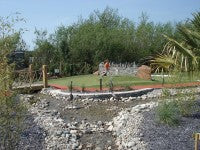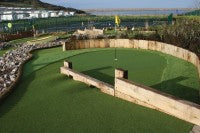How do we make golf more attractive?
 It seems to be an endless, recurring theme in golf conferences - well, we could start with making it less time-consuming. The golfing authorities could make it easier to participate in, or make it a less complicated sport to play.
It seems to be an endless, recurring theme in golf conferences - well, we could start with making it less time-consuming. The golfing authorities could make it easier to participate in, or make it a less complicated sport to play.
Golf is now an Olympic sport, and the way things are looking in the UK (a fully developed golfing nation), especially if the education system and/or the Government has anything to do with it, we'll be struggling to put together a consistent team of golfers in the future. The development of golf in juniors has always been the responsibility of the golf club, and not the school. The attitude outside the UK is very different.
Okay, there are now initiatives, such as Tri Golf - it is designed to be fun as well as informative; allowing those that take part to enjoy the game of golf, and feel the excitement that can come from competition in a sport that isn't as popular as national curriculum sports that are provided in schools. Tri Golf is a new form of developing junior golf produced by the Golf Foundation and it is targeted at children aged between 4 and 16.
I know a young golf professional in Cheshire who coached eight schools on a six week programme and, at the end of this time, each school took part in a golf festival where the pupils of each school played a tournament for the Tri Golf School Award - it was very successful. He's been asked to run the six week course again this autumn. He's also given juniors free golf lessons once a month to help to promote and improve future talent amongst the youngsters.
It's a good move forward, however, this professional is in the minority. Many are less interested in nurturing youngsters and encouraging them to take up the game - there's no incentive for them to do so.
Concerning the opportunities in this country - there has always been a desperate shortage of high quality, exciting and attractive golf courses and practice facilities that are open to the general public. Many private clubs in the country still have a situation whereby golfers hit their own balls into a mown grass field and collect them by hand.
 Municipal golf courses, as a recreational facility, have now become a very low priority within local authorities - in general they are too expensive to maintain, many struggle to break even and most lose money. Birmingham Council is currently tendering all of its seven golf courses Boldmere Golf Course, Cocks Moors Woods Golf Course, Hatchford Brook Golf Course, Hilltop Golf Course, Lickey Hills Golf Course, Pype Hayes Golf Course, Harborne Church Farm Golf Course (9 holes), for a private operator to take over. Whether a private operator is able to make any of them turn a profit remains to be seen. Why are they not making good money?
Municipal golf courses, as a recreational facility, have now become a very low priority within local authorities - in general they are too expensive to maintain, many struggle to break even and most lose money. Birmingham Council is currently tendering all of its seven golf courses Boldmere Golf Course, Cocks Moors Woods Golf Course, Hatchford Brook Golf Course, Hilltop Golf Course, Lickey Hills Golf Course, Pype Hayes Golf Course, Harborne Church Farm Golf Course (9 holes), for a private operator to take over. Whether a private operator is able to make any of them turn a profit remains to be seen. Why are they not making good money?
The quality of municipal facilities is, in general, poor and this is where the problem begins. Where else can a golfing beginner get an introduction to the game? Okay, they can visit a local, privately owned driving range and take a lesson with the local professional. However, many of these are stand-alone and have limited additional or ancillary facilities, i.e. practice chipping greens, bunker practice facilities and putting greens. This may be because of the cost of maintenance - these need to maintained to a reasonably high standard to give a realistic playing experience.
There are driving ranges with 9-hole courses attached, and this is an excellent formula - the Hazelwood Golf Centre in Sunbury-on-Thames, Middlesex, west of London is well-designed and was built in 1992 on a former landfill site for less than £1 million, including golf clubhouse, car parking, maintenance facilities and infrastructure. The land extends to not more than 25 hectares, and the course remains busy for golfers of all levels, especially juniors, where 9-holes of golf can cost as little as £8 and take only 1½ hours to play. This is a relatively new course, however, and the developer saw a niche in the market.
Many other golf course developments like this have been established in the past thirty years or so, many in the suburbs or on the edge of the urban fringe. Some have succeeded, others have not. Many are operated by private companies, such as Crown Golf or Burhill Golf & Leisure, specialists who know how to make these facilities profitable.
But, these facilities are proprietary -owned, pay and play courses, not municipal, therefore, not necessarily "open-access". Living in Leeds as a young boy, and before I had an official handicap, I remember playing golf on reasonable standard municipal golf courses, such as Gott's Park, Temple Newsam (designed by Alister MacKenzie), Middleton Park and Roundhay Park - all are still in play and they are, what you would say, fit for purpose.
I also played on the par-3 pitch and putt course in Horsforth Hall Park, which had a great "Himalayan" putting green alongside. It was such fun to play - we even paid to play it (when the park warden saw us) - but mostly played on evenings, early mornings or Sundays. We'd even take my dad's lawnmower there to cut the greens shorter as we became more demanding! These facilities have been allowed to return to rough grassland, sadly.
 I had the opportunity to play two municipal 18-hole pitch and putt courses in public parks in Norwich, at Mousehold Heath and Eaton Park - both nicely designed and really fun-to-play, and busy every weekend - you just hired a putter and a wedge. The Mousehold Heath site is now mostly covered by broad-leaved semi-natural woodland, although some areas of heath remain and are actively managed. Mousehold is part of north Norfolk's Heathland Heritage Project and has been funded through the Heritage Lottery Tomorrow's Heathland Heritage Project. The project aims to re-establish open areas of heather and gorse. This is a rare gem. There are other municipal classics, too - Belleisle in Ayr and Queen's Park in Bournemouth.
I had the opportunity to play two municipal 18-hole pitch and putt courses in public parks in Norwich, at Mousehold Heath and Eaton Park - both nicely designed and really fun-to-play, and busy every weekend - you just hired a putter and a wedge. The Mousehold Heath site is now mostly covered by broad-leaved semi-natural woodland, although some areas of heath remain and are actively managed. Mousehold is part of north Norfolk's Heathland Heritage Project and has been funded through the Heritage Lottery Tomorrow's Heathland Heritage Project. The project aims to re-establish open areas of heather and gorse. This is a rare gem. There are other municipal classics, too - Belleisle in Ayr and Queen's Park in Bournemouth.
When was the last municipal golf course built in the UK? I'm not sure - it would be interesting to know. New public golf facilities have not been built because so many private ones have satisfied demand. However, many of the new facilities do not necessarily attract complete beginners to the game - some have restricted access policies, excessive dress rules, are too expensive for many and have an atmosphere that is intimidating.
So, the courses at Birmingham Council may be loss-making, but can they be made more attractive to the beginner? What would need to be done to make them more attractive?
Well, these are ideas that might make a difference: make the 18-hole courses into 9-hole courses (with wider fairways and larger safety margins, both internally and externally), and add high quality practice facilities - floodlit driving ranges, for example, and an Adventure Golf Course - a bit like crazy golf, but of a higher standard, and using materials that don't need high maintenance.
Reducing the courses to 9 holes would reduce maintenance costs immediately. Adding better practice facilities and Adventure Golf would add two extra income generating opportunities. The land area saved by reducing the courses from 18 to 9 holes would also release space for other related, income generating facilities, for example, 5-a-side football pitches - like Goals.
The first course I designed was the Chesfield Downs Family Golf Centre near Stevenage, the brainchild of local golf professional, Martin Blayney, and Tim Franklin, a local farmer. The course has 27 holes (18 full length and 9-holes academy - The Lannock Links) and floodlit driving range, with a clubhouse catering for families, including a crèche. It was pretty revolutionary at the time, and it has continued to thrive under its new owners Crown Golf.
Today, the golf club must provide not only golf but a whole host of healthy related activities - and a well designed centre must cater for all social levels, ages and genders.
There has to be a revolution in the golf industry, and it must be led by the authorities who run the game - the R&A. They need to lead the way. They already encourage golf in foreign climes and developing golfing nations, through provision of (limited) funding, as a result of their highly successful Open Championship. But, they need to get involved at "grass roots" level in the UK - providing support for local authorities to develop entry level, municipal facilities. These don't need to be extravagant facilities, but they need to be designed to satisfy a demand that is currently untapped - the non-golfer.
Adventure Golf seems, to me, to be the missing link between the non-golfer and the golfer. It's not "real" golf, but it involves hitting a golf ball with a putter, and it is played within a carefully designed mini-golf course environment. It's open to anyone to play and it attracts families to the game. They then move on to the driving range and then the 9-hole course.
The future of golf lies in attracting the family unit and providing smaller, customer-focused facilities for all, that take less time to play. Oh, and increasing the diameter of the golf hole to 150mm.
Gaunt Golf Design Limited
jonathan@gaunt-golf-design.com
